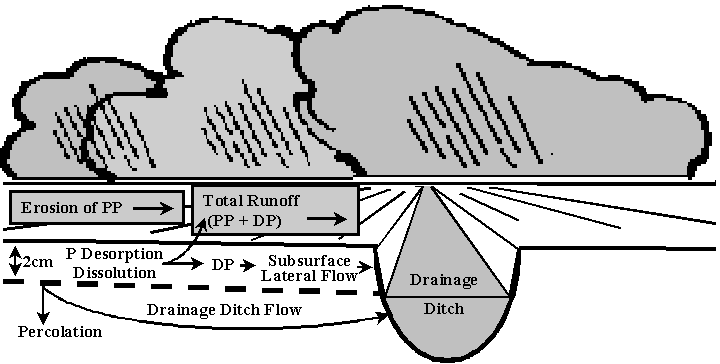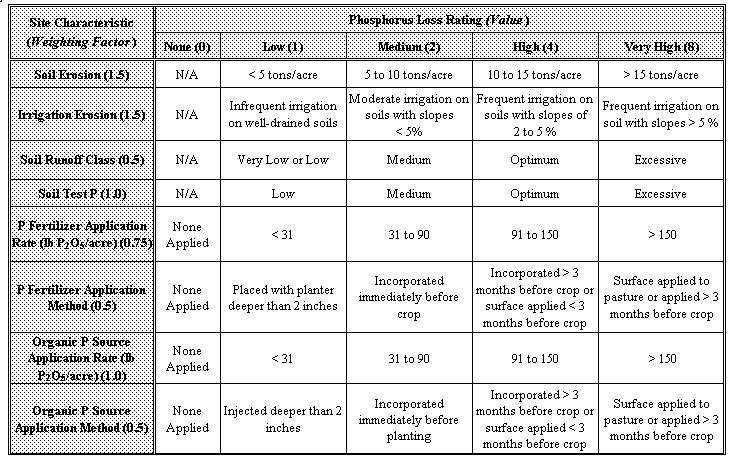
Nutrient Management Strategies for the Profitable, Environmentally Sound Use of Phosphorus
 |
Nutrient Management Strategies for the Profitable, Environmentally Sound Use of Phosphorus |
Introduction
Phosphorus (P) is essential for the growth and development of all living organisms. Phosphorus in fertilizer and manure is applied to cropland to achieve maximum crop yields and establish vegetation to reduce water, soil, and nutrient losses in erosion and runoff. Although there are no detrimental effects of P on the terrestrial environment, its transfer to surface waters has become a national pollution concern because P promotes the growth of aquatic vegetation in most fresh water bodies. Losses of P from cropland must be minimized to maintain water quality and ensure long-term agricultural sustainability.
Although P losses are generally not economically important to the farmer; they do carry the off-farm economic impacts associated with water quality deterioration. Remediating impaired surface waters is lengthy and expensive. Therefore, preventing the pollution of surface waters by P is the most economically efficient way to maintain water quality. Agriculturally, this means identifying and implementing profitable and environmentally sound P management practices that meet both agronomic and environmental goals. Such practices include constructing farm scale nutrient budgets, understanding the mechanisms of P losses, and implementing soil and water conservation practices to minimize P losses.
Nutrient Budgets
A P management program begins with a nutrient budget designed to calculate nutrient inputs to a farm in feed, fertilizers, and by-products, and nutrient outputs from a farm in crops and animal products. A nutrient budget helps a farmer determine if P inputs are exceeding P outputs, if P is accumulating in soils to excessive levels, and if P is being lost to the environment. On farms where commercial fertilizers are the only P inputs, soil tests and realistic yield goals will identify soil P status, crop P needs, and P fertilizer requirements. Grain analyses of harvested crops will quantify P leaving the farm. Fertilizer P inputs should be accounted for by P crop outputs and P remaining on fields in crop residue. Phosphorus inputs exceeding outputs reflect unnecessary fertilization.
When P inputs include commercial fertilizers and animal feed, a nutrient budget is more complicated. Feed P will accumulate in animal manure, which will typically be applied to fields as a nutrient source for crops, substituting partially or wholly for commercial fertilizers. Soil testing and yield goals will still identify soil P status, crop P needs, and P fertilizer requirements; and a manure analysis will identify available P in animal manure. Manure application rates should be based on crop nutrient requirements and manure nutrient content. Any P not supplied by manure can be supplied by commercial fertilizers. In most situations, manure application rates will be based on crop nitrogen (N) needs. Because of the high P content of most manures relative to N, this practice will often supply P to soil in excess of crop needs. Over time, soil P will accumulate to a level where no fertilizer P in any form should be applied. In these situations, alternative uses for animal manure other than land application, such as composting, pelleting, synthetic topsoil manufacturing, or bio-energy production, should be investigated (Sims and Vadas, 1997). Because animal based agriculture produces large quantities of manure and often relies on land application as the end use for manure, it is especially important that farm P inputs do not exceed P outputs. Crop and animal product analyses and animal nutrient content estimations will identify the quantity of P leaving the farm. If P inputs exceed P outputs, then P management options that reduce P inputs, that use on-farm P resources without promoting P losses, and that increase P outputs should be investigated. This will help ensure that P does not accumulate on the farm and the potential for off-farm P losses does not increase.
Fertilizer Application Strategies
Losses of P from commercially fertilized soils are influenced by the rate, time, and method of fertilizer application. After application, the most P will be lost from fields where high rates of P are applied, where P is broadcast and unincorporated, and when intense runoff events occur soon after P application. The least P will be lost from fields where little P is applied, where P is knifed into the soil in bands, and when intense runoff events occur well after application. Most fertilizer application strategies fall between these two extremes. However, just as environmentally sound P management should not prevent a farmer from optimizing profits, the constraints of time, equipment, and cost should not prevent a farmer from trying to minimize off-farm P losses.
Land application of animal manure can be a significant source of P to crops, but can also cause P losses depending on the rate, timing, and method of application. As with commercial fertilizers, the most P will potentially be lost from fields where large quantities of manure are applied, manure is left unincorporated, and intense rainfall occurs soon after application. Phosphorus losses are least when manure is applied at rates that match fertilizer needs, manure is incorporated, and rainfall is infrequent. Because these conditions reduce the number of application opportunities available throughout the year, manure should be stored in suitable facilities until it can be applied.
Mechanisms of P Loss from Agricultural Fields
Phosphorus is lost from agricultural fields as either a soluble form dissolved in surface runoff and subsurface, laterally flowing water (Dissolved P, DP) or a particulate form bound to eroded soil particles or organic matter (Particulate P, PP). As rainfall interacts with the surface 2 cm of soil, P will dissolve off of soil particles, crop residues, fertilizers, and manures. This DP can either leave a field in surface runoff, move through the soil and leave a field in subsurface, laterally flowing water, or percolate into the soil where it may eventually leave a field in water drained by tile drains or drainage ditches. However, as DP moves along the surface of soil or through soil, it may be resorbed by soil or runoff sediment and become PP. The eroded sediment load leaving a field in surface runoff will determine the extent of PP losses. Figure 1 illustrates the various mechanisms by which P can leave agricultural fields.

Figure 1. Schematic of P loss from agricultural soils through erosion, runoff,
subsurface lateral flow, and drainage.
Soil and Water Conservation Practices to Control Surface Runoff and Erosion
To minimize DP and PP loss from fields via surface runoff and erosion, it is necessary to reduce rainfall impact on the soil surface, reduce runoff volume and velocity, and increase soil resistance to erosion. Tables 1, 2, and 3 outline various tillage, cropping, and conservation practices that can help achieve these goals.
Table 1. Tillage practices to reduce runoff and erosion and subsequent agricultural P losses.

Table 2. Cropping practices to reduce runoff and erosion and subsequent agricultural P losses.

Table 3. Conservation practices to reduce runoff and erosion and subsequent agricultural P losses.

The Phosphorus Index
To minimize P losses, management practices must control both the supply and transport of soil P. Cropland with a high potential to supply P but a low potential to transport P, and vice versa, will lose much less P than cropland with a high potential to supply and transport P. The Phosphorus Index is a rating system that evaluates a soil’s potential to lose P based on eight characteristics (Sims, 1996). Each characteristic is assigned a rating value and weighting factor, which combined reflect its potential for and relative importance to P loss (Table 4). The P Index for a soil is calculated by multiplying the rating value by the weighting factor for each characteristic and summing all eight products. The potential for the soil to lose P is based in the final sum (Table 5).
Table 4. The P Index for Delaware.

Table 5. Generalized interpretation of the P Index.

Daniel, T.C., A.N. Sharpley, D.R. Edwards, R. Wedepohl, and J.L. Lemunyon. 1994. Minimizing surface water eutrophication from agriculture by phosphorus management. J. Soil Water Conserv. 49:30-38.
Sims, J.T. 1996. The phosphorus index: A phosphorus management strategy for Delaware’s agricultural soils. Univ. of Del. Newark, DE. Cooperative Bulletin ST-05.
Sims, J.T. and P.A. Vadas. 1997. Value added products from poultry wastes: Alternatives to land application. Univ. of Del. Newark, DE. Cooperative Bulletin ST-12.
Troeh, F.R., J.A. Hobbs, and R.L Donahue. 1991. Soil and water conservation. Prentice Hall, Englewood Cliffs, NJ.
Click here to close and return to the STP Publications Page